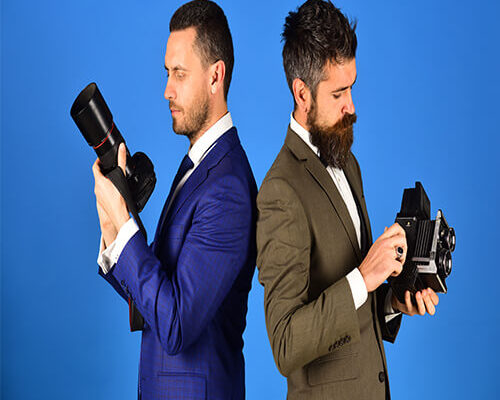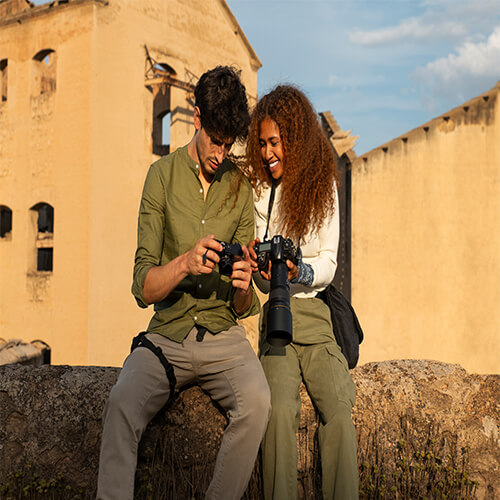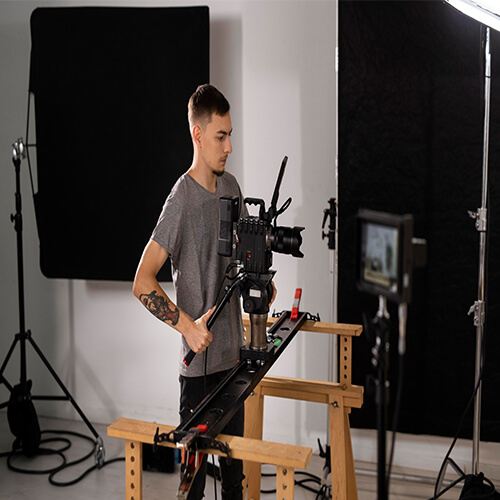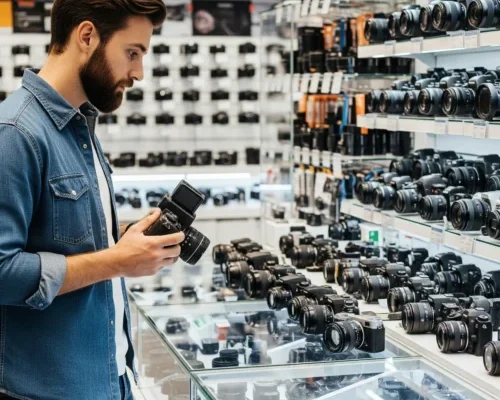Finding your dream camera can be tricky with so many models and features out there…

Photography vs Videography: Revealing Top 10 Key Differences
Photography and videography are two closely related yet distinct forms of visual storytelling. Photography vs videography both involve capturing and conveying a moment or message, but they differ significantly in their techniques, equipment, and post-production processes. In this article, we’ll explore the top 10 key differences between photography and videography, helping you understand the fundamental distinctions between these two creative fields.
What is the difference between photography and videography?

Understanding Photography

Photography is a still image medium that has been the cornerstone of visual storytelling for centuries. Photography vs videography, it’s an art form that requires a deep understanding of composition, lighting, and exposure. Photographers use a variety of cameras and lenses to capture a single moment, freezing time and conveying a message through a single frame.
From portrait photography to landscape photography, the art of photography is diverse and constantly evolving. Photographers use a range of techniques, including aperture, shutter speed, and ISO, to control the look and feel of their images. The goal is to create an image that tells a story, evokes an emotion, or simply captures a moment in time.
Understanding Videography

Videography is a time-based medium that involves capturing and editing moving images. Photography vs Videography, it’s a dynamic and constantly evolving field that requires a deep understanding of lighting, sound, and editing software.
From music videos to documentaries, the art of videography is diverse and constantly pushing the boundaries of what’s possible. Videographers use a range of techniques, including camera movement, lighting, and sound design, to create a narrative or convey a message.
1. Capturing Moments
Photography and videography both aim to capture moments, but they approach this task differently. Photography captures a single moment in time, whereas photography vs videography records a sequence of moments over time. Understanding the fundamentals of both mediums is crucial for effective storytelling in either field.
Photography relies on composition, lighting, and exposure to capture a moment, whereas videography uses frame rates, resolutions, and editing software to create a narrative. By understanding the basics of both photography and videography, artists can develop the skills needed to tell compelling stories in either medium.
2. Frame Rates and Resolutions
One of the most significant technical differences between photography and videography is frame rate and resolution. Photography typically involves a single still image, whereas videography captures a sequence of frames. The frame rate, measured in frames per second (FPS), determines the smoothness and motion of the video.
Resolution, measured in pixels, determines the clarity and detail of the image or video. Higher frame rates and resolutions create a more realistic and engaging visual experience. Understanding the technical specifications of both photography and videography is essential for producing high-quality images and videos.
3. Storytelling Techniques
Photography and videography both use storytelling techniques, but they approach narrative structures differently. Photography tells a story through a single image, while videography conveys a narrative through a sequence of frames.
Photography often relies on context, composition, and symbolism to convey a message, whereas videography uses editing, music, and sound design to create a narrative. Understanding the storytelling techniques used in both photography and videography is crucial for effectively communicating a message or telling a story.
4. Equipment and Gear
Photography and videography both demand specialized equipment tailored to their respective mediums. Photography vs videography primarily revolves around the use of cameras, lenses, and supplementary accessories like tripods and filters. In contrast, videography necessitates additional equipment such as lighting setups and sound recording gear alongside cameras and lenses.
Understanding the nuances of equipment for both photography and videography is pivotal for achieving optimal results. Whether selecting camera bodies that suit specific photographic styles or choosing editing software that enhances video production, having the right tools can markedly enhance the quality and impact of your visual creations.
Investing in quality gear tailored to the demands of each medium can significantly elevate the production value and artistic expression in both photography and videography. By mastering the intricacies of equipment selection and utilization, photographers and videographers alike can effectively translate their creative vision into captivating visual narratives.
5. Composition and Framing
Composition and framing are critical skills in photography vs videography. These techniques involve strategically arranging elements within a frame to compose a compelling visual narrative. Photography typically focuses on static composition to capture a single, impactful moment, while videography employs camera movement, panning, and zooming to add dynamism and depth to the storytelling process. Understanding these principles is crucial for crafting engaging visuals that resonate with viewers across both static and dynamic mediums.
Photography often relies on static composition, whereas videography uses camera movement, panning, and zooming to create a dynamic visual experience. Understanding the art of composition and framing is essential for creating visually appealing images and videos.
6. Lighting and Exposure
Lighting and exposure are indispensable elements in both photography and videography. They directly influence the aesthetics and impact of images and videos, shaping mood, highlighting details, and setting the overall tone. Skillful manipulation of lighting can elevate a visual presentation, while insufficient or poorly managed lighting can detract from its effectiveness.
In photography, photographers often utilize natural light or employ artificial lighting setups to achieve desired effects. They adjust exposure settings to control how light interacts with the camera sensor, ensuring optimal brightness and contrast levels in their photographs. Videography, on the other hand, encompasses a broader spectrum of lighting techniques, integrating natural light, various types of artificial lighting, and meticulous camera settings adjustments to maintain consistent visual quality throughout video sequences.
Understanding the nuances of lighting in both photography and videography is fundamental for creators aiming to produce compelling visual content. Mastery of lighting techniques not only enhances technical proficiency but also enriches storytelling capabilities, allowing for effective communication of themes, moods, and narratives through visuals.
7. Post-Production and Editing
Photography and videography both involve post-production and editing, but the approaches differ significantly. Photography often involves minor adjustments, such as cropping and color grading, whereas videography requires more extensive editing, including cutting, arranging, and enhancing footage.
Understanding the post-production and editing process for both photography and videography is essential for refining your images and videos. From software to techniques, the right tools and approaches can make a significant difference in the quality of your work.
8. Sound Design and Audio
Sound design and audio are critical components of photography vs videography, but less so in photography. Videography uses music, sound effects, and dialogue to create a narrative or convey a message, whereas photography often relies on visual elements alone.
Understanding the role of sound in videography is essential for creating an immersive and engaging visual experience. From music selection to sound design, the right audio can make a significant difference in the quality of your work.
9. Visual Style and Aesthetics
Photography and videography are distinct in how they utilize visual style and aesthetics to communicate narratives. Photography focuses on capturing singular, impactful moments through meticulous composition, deliberate lighting choices, and precise control of exposure. These elements work together to craft visually striking images that resonate emotionally or intellectually with viewers.
In contrast, photography vs videography employs a more dynamic approach by incorporating camera movement, editing techniques, and sound design to convey stories that unfold over time. Camera angles, transitions, and pacing play crucial roles in creating a cohesive narrative flow, enhancing viewer engagement through visual and auditory immersion.
Both mediums share the common goal of using visual elements to evoke emotions and convey messages effectively. Understanding and mastering the unique visual styles and techniques of photography and videography empower creators to craft compelling visual stories that leave a lasting impression on their audience.
10. Career Paths and Specializations
Photography and videography both offer career paths and specializations, but the opportunities differ significantly. Photography vs videography often involves specialization in areas such as portrait, landscape, or wildlife photography, whereas videography includes specializations in areas such as filmmaking, documentary production, or live event coverage.
Understanding the career paths and specializations available in both photography and videography is essential for finding the right niche or pursuing a career in either field.
Conclusion
Ultimately, photography vs videography represent two distinct yet interconnected forms of visual storytelling. Photography excels in capturing singular moments with precision, leveraging composition, lighting, and exposure to freeze time and convey emotion through a single frame. On the other hand, videography unfolds narratives over time through sequences of images, utilizing techniques like camera movement, editing, and sound design to create dynamic stories that engage viewers continuously.
Both mediums have evolved significantly from their origins, each requiring specialized techniques, equipment, and artistic approaches. While photography focuses on the art of the still image, videography extends storytelling capabilities through motion and sound, pushing boundaries in cinematic expression and immersive experiences.
Whether choosing photography or videography as a creative pursuit or professional career, understanding their unique attributes and technical demands is crucial for effectively harnessing their storytelling potential and achieving impactful visual communication.
Read Next: How to Become a Professional Photo Editor: Tips and Guide




Comments (0)